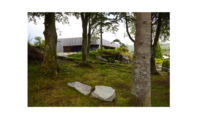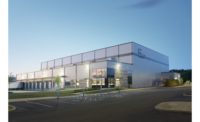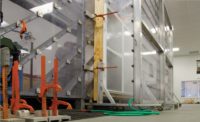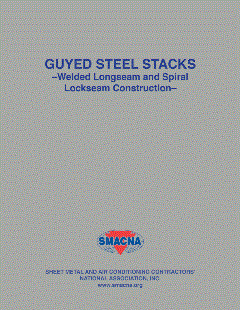The State of Steel

Over the past year, domestic steel stud manufacturers experienced one of the most volatile, unsuspecting and outright damaging markets in recent history. The ups and downs of 2008 have tried and tested each of the nation’s steel framing manufacturers, and shaken the building products industry to its core. So, how did we cope with it and what are we going to do as manufacturers in order to survive?
First and foremost, we need to analyze what truly happened. After identifying the causes and how they affected us, we can begin to put in place certain mechanisms that are intended to stabilize not only our company but also those of the industry. Lastly, we’ll attempt to give you a glimpse of what we see happening in 2009 and beyond as it relates to steel stud manufacturers.
Before we look at 2008, let’s briefly revisit the 2004 steel crisis. Many domestic steel manufacturers prior to 2004 were either faced with bankruptcy, or very near the edge of it. Consolidation began to take place in a very fragmented domestic steel market, and in late 2003 to early 2004, supply was limited from U.S. steel companies. With the aid of imported steel, the market survived, and learned a few good lessons on the way. The likelihood of this occurring in the near future was small, or so we thought.
Many of the world’s leading analysts, most of them having lived through prior steel crises, were comfortable in forecasting a relatively positive demand curve along with fairly stable prices for 2008. Everyone believed that China was still going to consume vast amounts of steel and that the U.S. economy was going to chug along, at least for the foreseeable future. That, however, was short lived as the evidence below supports.

Since January of this year, the cost of hot-dipped galvanized steel has increased approximately 80 percent. These increases were far from planned, and came to the entire industry as a complete surprise. Our expectations and forecasts for typical inflationary increases over the year were shattered quickly. There are a few distinct reasons as to why costs of steel rose so quickly and with such magnitude. First, raw material, transportation, and energy input costs increased substantially. Costs for iron ore, scrap metal, diesel fuel, gasoline, natural gas, and electricity were all moving upward at increasing rates.
Beginning January 2007 through July 2008, prices for raw materials such as iron ore and scrap steel, both base components of steel sheet, soared upwards of 65 percent and 142 percent respectively. Energy costs, in particular natural gas and electricity, rose approximately 70 percent and 22 percent respectively. When combining these four basic components of steel production, one can easily begin to comprehend the magnitude of what domestic steel producers were faced with on the cost side of the equation. Secondly, global demand for galvanized steel sheet was heavy. China was the prime reason for high demand in the Asian market, in particular for the building boom prior to the 2008 Beijing Olympics. Other emerging countries, such as India, were also experiencing their own versions of internal growth, setting records on demand for steel. In addition to a heavily burdened global supply market for steel, a weakened U.S. dollar, and a limited amount of imports coming into the United States, domestic mills were able to run near capacity and capitalize on pricing.
Domestic mills were also able to sell their products off-shore thus taking advantage of the typically better conversion rate often associated with this economic condition. U.S. mills enjoyed respectable spreads between costs and revenue in 2007 and continued their efforts to increase exports to global customers well into the first three quarters of 2008. As 2008 began, the demand for steel framing products was continuing to climb. Supported by strong indicators seen in the previous two quarters, everyone assumed it would continue through the year. So based on these reasons, 2008 was looking to be a solid year, despite the fact we estimated typical increases from the steel mills due to limited supply. Unfortunately, even some of the industry’s most respected analysts couldn’t foresee what actually transpired.
POINT OF VIEW
From a manufacturer’s perspective, the effects of these conditions had taken various forms of higher costs. Every facet of our variable cost structure was impacted from the obvious (higher steel sheet costs), to less visible, such as legacy, inventory, and opportunity costs. Due to what we refer to as “panic-buying,” the majority of our customers placed additional orders so their supply of steel framing products would remain as close to “normal” as possible, trying to avoid large holes in their respective inventories as the domestic supply of steel continued to tighten. This panic buying on the part of the dealers and distributors was exacerbated by similar purchasing tactics downstream by the contractors and framers securing their availability of framing products to minimize interruptions in their production schedules.
While all of these entities were rushing to secure their orders with manufacturers, the pressure on manufacturers to secure their orders upstream with the domestic mills also increased, thus overloading the system with up to three times the typical tonnage as seen in 2006 and 2007. Commonly referred to as hedge-buying in other industries, we refer to this phenomenon as “false-demand.”
False demand exists when the orders for steel framing and metal lath products exceeds the typical production cycle. In other words, there are more orders that are in-line for production than the production cycle can accommodate in a typical five-day manufacturing schedule. The most damaging common effect this has on the contractor is extended lead-times. Steel stud products are usually delivered within three to five days from the time of order.
However, when this loading-up of orders hits manufacturers, these lead-times often extend well beyond the typical five days, sometimes hitting four or five weeks. Obviously, the contractor is now in a position of having to juggle production schedules, and that exposes him to higher costs such as construction delays resulting in liquidated damages. Additionally, this hedging effect runs upstream to the steel mills, giving them a false sense of true demand for steel, and typically causes them to seek higher and higher prices because the “market will bear it,” thus creating an unending cycle of increased demand triggered by expected higher and higher prices. The strains of this false-demand market also put pressure on stud manufacturers’ profits.
SECONDARY MARKETS
One option was to look to other sources of steel such as the secondary market. This secondary market for steel is one that developed from steel mills’ desire to minimize scrap/sub-standard material. Secondary steel is often graded as such due to minor imperfections in steel produced for orders requiring strict quality requirements and specifications. Examples typically involve inadequate galvanized coating, small surface imperfections, incorrect chemistry requirements, and gauge/thickness deviations. The steel available in this market may not necessarily be defective, but yet is still rejected by mill customers due to one or more of the aforementioned reasons. This steel cannot be classified as Mill-Certified Prime, which is what many of the steel stud manufacturers known for their high-quality products typically use.
However, many purchasing agents look here to procure cheaper steel that is close to their quality standards, and can be used in applications not requiring specific chemistry for structural or load-bearing attributes. However, as it is with many other products such as food or clothing, the higher the quality of input materials is, the higher the quality of the finished product. Unfortunately, there have also been instances where non code-complaint steel makes its way to the end user, resulting in job-stoppages, lost production time, and replacement costs. This option is often the last resort for manufacturers concerned about their reputation in the marketplace, since it is reputation that often takes years and years to develop, and only moments to destroy.
Regardless of the cost cutting measures taken by manufacturers, the reality of the situation became evident in early 2008. With a strong backlog of projects, most manufacturers needed to look closely to those locked-in prices used to generate the majority of their respective revenues. For decades, steel stud manufacturers were often asked to bid large-scale projects for extended periods of time, sometimes extending well into 12 to 18 month commitments.
PRICING ESCALATORS
In typical market conditions, and since steel stud manufacturers place their orders three to six months in advance, we protected ourselves and our customers by inserting pricing escalators based upon our historical experience in years past. These escalators historically ranged between 5 and 10 percent, depending upon what we saw as the foreseeable future and our past experience with steel mills. For the most part, this system has worked successfully. However, as 2008 unfolded, the “legacy” costs, those which result from past commitments to our customers via the project quoting process, quickly became the single most costly result of these market conditions. Despite the fact that many of these projects were committed to us by our customers during more stable times, we were bound to honor those prices despite the meteoric rise in costs throughout 2008. The spread between prices to our customers and our cost of steel, while supplying these projects, continued to evaporate.
As the year went on many of those spreads disintegrated, resulting in losses for us and other manufacturers. Not knowing if our increased costs for steel would slow down or accelerate, or even reverse, manufacturers looked carefully at any and all options to mitigate the damage for the foreseen future.
The response from some manufacturers was to put artificial deadlines or expiration dates on all new project quotes in hopes of minimizing their exposure to the fluctuations in the steel market. We have seen two manufacturers announce 180-day time limits on project quotes. As anyone with experience in the construction industry knows, this short time limit is fine for small scale projects. However, with larger scale projects, such as schools, hospitals, commercial buildings, and office towers, 180 days is too short and can potentially expose both manufacturer and contractor to unrealistic expectations, especially in regards to containing costs in a volatile market over the life of the project. Our response was a much more realistic approach to the problem of market price volatility.
FORWARD LOOKING SOLUTIONS
We started our solution by looking back to carefully analyze what happened in the past three decades, compared it to the 2008 market, and devised a plan that would satisfy our vendors, our customers, and ourselves. We knew that any solution would demand equitable and willing participation in order to be both acceptable and successful. California Expanded Metal Products Co. then developed the Project Purchase Agreement. The main purpose of the Project Purchase Agreement was to create a document whereby each party’s respective expectations and responsibilities were listed and upon signing, would bind CEMCO, our customer, and the end user/contractor, to perform to those standards, regardless of the market conditions. (See the PPA on page 23 for specifics.)
After extensive meetings with our largest customers and their largest customers, we developed a solution that was acceptable to each of the three parties. By committing to perform as indicated, CEMCO took on the responsibility to guarantee service and price for the entire project. By doing so, our customers could be confident in CEMCO’s ability to perform as stated, guarantee to their customers that their expectations would be met, and feel confident that everyone’s profit margins would be preserved regardless of what the steel market does in the future.
Looking forward to 2009, we are foreseeing a difficult year, marked by a significant downturn in overall business, especially residential and commercial construction. Despite the glib outlook, the company is continuing to prepare for the slowdown by instituting programs that will not only focus on internal cost-cutting measures but also look to our customers and contractor base on how we can further help them cut costs in conjunction with our efforts. By including our customer base in our planning, we intend to create a more solid, stable and efficient business model that will better the industry as a whole. We strongly feel that 2009 is a time in which we can truly change how we come to market, do so in a stronger way, and still provide to our customers the best service, quality, and support. W&C
Looking for a reprint of this article?
From high-res PDFs to custom plaques, order your copy today!









